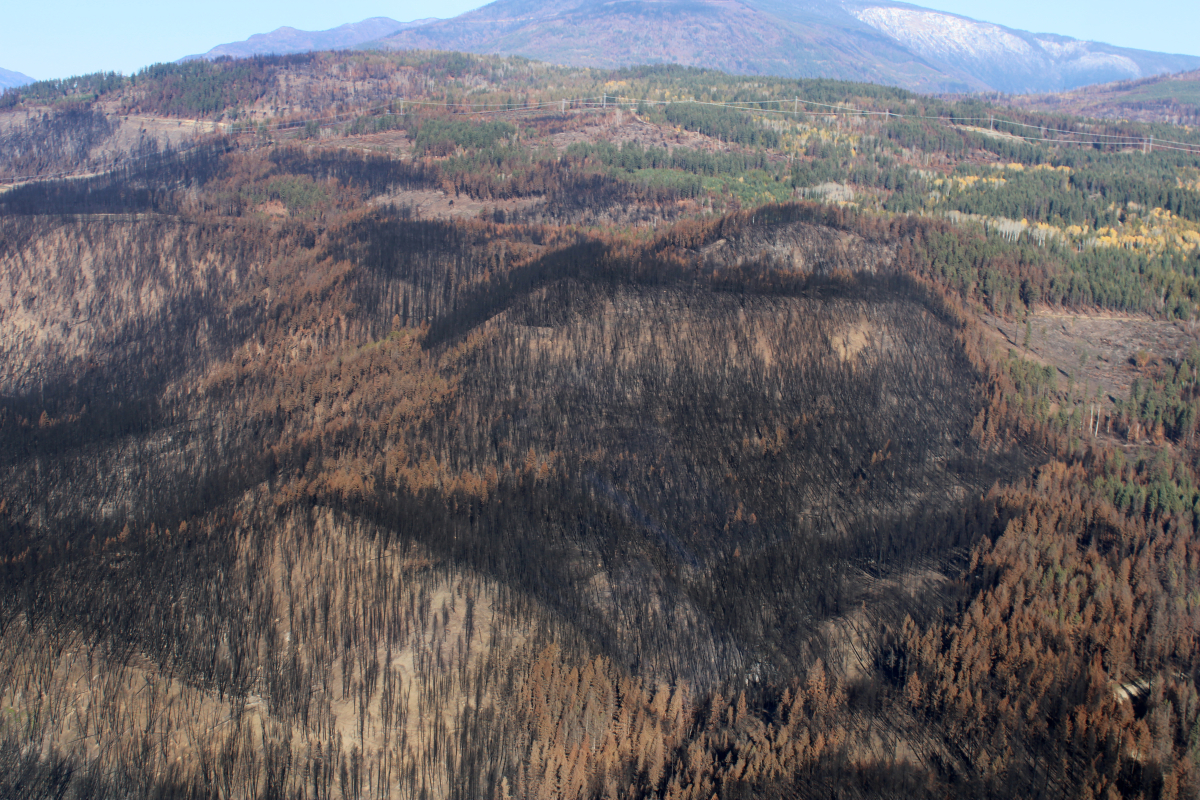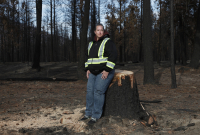Support strong Canadian climate journalism for 2025
On the day of the evacuation, Ashia Hunt felt thankful she and her child had beat the flames bearing down on their community in the B.C. Interior. But her brother, where was he? Had he survived?
Hunt texted her brother, Joel Hunt, until she couldn’t. Hunt’s phone died halfway through that August night and no one could reach him.
“I thought he was gone,” she said. “Because, to be fair, I thought everything was gone.”

Most community members of Skwlāx te Secwepemcúl̓ecw, a First Nation 70 kilometres east of Kamloops, were evacuated at a moment’s notice when the Bush Creek wildfire hit the community in August.
But not Hunt’s brother, Joel, who’s a member of Skwlāx’s volunteer fire department. He stayed behind to help save what structures he could. It was a suffocating night marked by an orange glow, black smoke and the sound of water bombers circling overhead.
It all started when the Bush Creek wildfire climbed over the mountains and swept into the valley where the First Nation sits. When the fire passed through, it destroyed 64 structures, including 34 homes, and left the once lush forest looking like a swath of upright, used matchsticks.

Everyone from the Skwlāx community has a story of the Bush Creek fire, it seems. Community members recalled their terrifying experiences when Canada’s National Observer was invited to return in November after the fire was finally out and the area deemed safe enough to enter as part of our investigation on the disproportionate impacts of wildfires on First Nations.
In 2023, over 95 Indigenous communities were evacuated, more than during the four previous fire seasons combined, according to data collected from Indigenous Services Canada (ISC).
The disproportionate burden of wildfire on Indigenous communities is worsening in lockstep with climate change. Severe weather patterns coupled with heat waves that start earlier and last longer cause megafires with devastating consequences that don’t end once a community reaches safety.
The story of wildfire, and the communities ravaged by them, is also about the long and spiralling story of recovery.

For example, the village of Lytton, also in the B.C. Interior, was only issued its first building permit in November this year, more than two years since the community was destroyed by wildfire. Lytton First Nation, the Indigenous community that neighbours the village, hasn’t fared much better. The First Nation is only just beginning the rebuilding process, according to its band’s newsletter.
But now following the devastation, Skwlāx te Secwepemcúl̓ecw is in a strong position to recover thanks to the economic engines of the community and provincial and federal support that will help the community rebuild homes, Kukpi7 (Chief) James Tomma told Canada’s National Observer.
But the journey will be long, marked by challenges that linger in the back of the minds of people in neighbouring bands, like Lytton, who went through similar devastation.
Why Skwlāx says their rebuild will be different
Skwlāx te Secwepemcúl̓ecw is one of the leading employers in the Little Shuswap Lake area, with 300 employees in several different industries.
Before the Bush Creek fire, the band hosted a thriving tourism industry with its Quaaout Lodge, which includes a hotel, spa and conference and event centres. The lodge also has a bistro-style restaurant marked by gourmet burgers, and omelette and prime rib stations and sits across from the Talking Rock Golf Course, respected as one of the best in the region.

The natural beauty of the First Nation, on the edge of Little Shuswap Lake where the sun glistens over the fresh water and mountains braid a shaded pattern into the landscape, helped attract investment and revenue sources, Tomma said.
Skwlāx te Secwepemcúl̓ecw also owns a gravel esker, which has the potential to bring in $1.5 billion over 90 years for the children of Skwlāx, Tomma said.
“With all [these] ventures … I feel like I laid the foundation so that our children will have the ability to not have to rely on anybody,” he said. “They’ll be able to determine how things are going to go for them.”
However, there was a time following the fire when Tomma did not know if he would be able to keep everyone employed. For now, Quaaout Lodge is functioning as a band office, while the golf course has been shuttered since the fire.
“It was a tough call telling people that there might not be … jobs for everyone,” he said. “It’s a brutal fact.”

The gravel pit was one of the first things to get back up and running following the fire’s devastation since all the equipment was left unscathed. The gravel will also be used in the rebuild, saving the community money.
Revenue from tourism and the gravel pit will help lower reliance on ISC and other governments for the rebuild and beyond.
It’s an essential departure from where some less lucky First Nations are left, given the fickle ebbs and flows of government budgets. Earlier this year, ISC said it is set to cut upwards of $7 billion with expiring programs, CBC Indigenous reports.
Even fire cleanup has been supported by community-run businesses. Joel Hunt, the firefighter who stayed through the night defending structures, worked for weeks on end for BeaverTooth, managing tree removal around the community.
After a wildfire, trees with damaged roots can snap at a moment’s notice. Those trees, sometimes called “widow-makers” by wildland firefighter professionals, can remain dangerous for months following a fire.

The workload has been intense for BeaverTooth, run by Jason August. August has hired cousins and others to support the work of clear-cutting deadly trees, which will take months, maybe even years.
Rebuilding homes and other buildings may take even longer, said Leslie Quanstrom, executive director of administration at Skwlāx, who leads the rebuild.
For eight weeks following the fire, administrative staff worked around the clock with email access and phones nearby. Much of the community stayed in evacuation camps for weeks before moving into hotels.
Community members with homes that survived the fire had to wait weeks for professional cleaning to be finished to ensure harmful toxins were removed. For those without homes, the wait for a new one is unclear. Skwlāx is looking at stick-built homes or high-end modular homes to ensure a quick return and long lifeline, depending on what community members want.
“We’re going to meet with our members and build to their needs,” Quanstrom said.

Tomma, who lost his home in the fire, has made it clear that he intends to be the last one to move into a new building. He reckons he won’t see a home for two or three years, possibly longer.
“I can’t build my house until the last band member opens and closes their door behind them,” he said.
A community coming together
Some people whose houses survived told Canada’s National Observer they felt guilty and confused knowing their homes were still standing, while others will have to remain in hotels until the rebuild is complete. Some plan to open their homes to family and friends.
In some ways, the tragedy has knit the community closer together, Hunt said. Hunt has spent more time with her cousins while living in temporary housing at the hotel than ever before.
“It's more family now since it's happened,” she said.
Matteo Cimellaro / Canada’s National Observer / Local Journalism Initiative





Comments
Thank you for this article. While the news cycle has moved on to other topics, so many people are still suffering from the losses of last summer's wildfires. The story is not over for them and won't be for quite awhile. And what will next summer be like? Do we forget about these Climate Change impacts too easily?
Yes, we forget to easily. And we forget to fast. Thank you for your comment, Patricia. We are so encouraged by our readers.